
Sacred Texts Sub Rosa Index Previous Next
Buy this Book at Amazon.com

THE branch sect of the Gnostics, called Basilideans, who were properly Ophites, arose in the second century, deriving their name from Basilides, the chief of the Egyptian Gnostics. They taught that in the beginning there were Seven Being's, or Æons, of a most excellent nature; in whom we recognize the cabalistic Seven Spirits before the Throne. Two of these first Æons, called Dyamis and Sophia--that is 'Power' and 'Wisdom'--engendered the, angels of the highest order. The name of Abraxas; the Deity of the Gnostics, is made up of 'the numerical letters representing the total 365--the aggregate of days of the solar year. The 'manifestation' of Abraxas rests in his Son, Nūs (knowledge), or Christ, the chief of the Æons, who descended to earth and assumed the form of 'Man'; was baptized, and crucified in appearance (Mosheim's Eccles. Hist. vol. i. pp. 181-4). The Manichæans, who deny the reality of the Crucifixion of the Son of God, and whose tenets concerning the Saviour Jesus are peculiar, derive their name from Manes, or Mani; and their doctrine was first disseminated in Persia about the year 270. They speak mysteriously of the Anima Mundi, or 'Hyle'; they call this principle a deity, and agree with the Rosicrucians in asserting that it is a power presenting itself at once in reverse to the world and to the heavens, in as far as that, while it is dark to the one, it is light
to the other; and contrariwise. The Gnostic hierarchy consisted of an arch-priest or patriarch, twelve. masters, and seventy-two leaders or bishops. The Gnostics called Matter, or Body, 'evil', and 'darkness', and seemed uncertain whether, in its operations, it were active or passive. It was believed by these sectaries that there were successive emanations of intelligent beings--these were the Æons (αἰῶνες), producing the various phases in creation. In this way, there arose in time a mighty being, the Demiurge, who set to work on the inert matter then existing, and out of it formed the world. The reconcilement, or restoration, is to the Bhuddistic pleroma, or fullness of light. It is absorption into 'annihilation', or into victory, oblivious of the vexations of 'life'. Here, in this fullness of light--or independence of all worlds, or of life, according to Man’s ideas--the Supreme God has His habitation: but it is not 'nothingness', according to our ideas of nothing; it is so only because it has not anything in it comprehensible. The Alexandrian Gnostics inclined to the opinion that Matter was inert, or passive; the Syrian, Gnostics, on the contrary, held that it was active. Valentinus came from Alexandria to Rome about A.D. 140. St. Augustine fell under the Gnostic influence, and retained their beliefs from his twentieth to his twenty-ninth year--viz., from 374 to 383 A.D. Their books have for titles: the Mysteries, the Chapters or Heads, the Gospel, and the Treasure. Refer to Beausobre, Walch, Fuësslin, and Hahn.
The Gnostics held that Christ's teaching was not fully understood even by His disciples; and therefore He promised to send, in due time, a still greater Apostle, the Paraclete, who should effectually separate truth from falsehood. This Paraclete appeared in Mani.
The West Front of Lichfield Cathedral displays
accurately the mythic idea of the union of the Male and Female Principles in the parallel double towers, which are uniform.
The claims for the real reading of the Egyptian hieroglyphics are distinct and unhesitating, as put forward by the Egyptologists; who, if industry could have succeeded, certainly would have realized their desire. But it is extremely doubtful whether, after all, they are not very widely astray. The late Sir George Cornewall Lewis, in his History of Ancient Astronomy, has disposed conclusively of the assumed correctness of most of these interpretations. The Egyptologists, the principal of whom are Champollion, Rawlinson, Dean, Milman, Sir George Lewis (perhaps the best critic), Professor Wilson, Sir Gardner Wilkinson, Dr. Cureton, Dr. Hincks, M. Oppert, Mr. Fox Talbot, with a large amount of ingenious and very plausible research and conjecture, have not truly touched or appreciated these enigmas. They yet remain, baffling the curiosity of the moderns; and they are likely to preserve their real mysteries unread as long as the stones of the Pyramids and the remembrance of the Sphinx--if not her visible figure--themselves endure. We believe that there is no adequate mystical comprehension among modern decipherers to read the hopeless secrets--purposely evading discovery--which lie locked in the hieroglyphics: the most successful readings are probably guesses only, founded on readily accepted likeness and likeliness.
The Temple Church, London, presents many mythic figures which have a Rosicrucian expression. In the spandrels of the arches of the long church, besides the 'Beauséant', which is repeated in many places, there are the armorial figures following: 'Argent, on a cross gules, the Agnus Dei, or Paschal Lamb,
or'; 'Gules, the Agnus Dei, displaying over the right shoulder the standard of the Temple; or, a banner, triple cloven, bearing a cross gules'; 'Azure, a cross prolonged, potent, issuant out of the crescent moon argent, horns upwards; on either side of the cross, a star or'. This latter figure signifies the Virgin Mary, and displays the cross as rising like the pole, or mast of a ship (argha), out of the midst of the crescent moon, or navis biprora, curved at both ends; 'azure, semée of estoiles, or'. The staff of the Grand Master of the Templars displayed a curved cross of four splays, or blades, red upon white. The eight-pointed red Bhuddist cross was also one of the Templar ensigns. The temple arches abound with brandished estoiles, or stars, with wavy or crooked flames. The altar at the east end of the Temple Church has a cross flourie, with lower limb prolonged or, on a field of estoiles, wavy; to the right is the Decalogue, surmounted by the initials, Α. Ω. (Alpha and Omega); on the left are the monograms of the Saviour, Ι C∙Χ C; beneath, is the Lord's Prayer. The whole altar displays feminine colours and emblems, the Temple Church being dedicated to the Virgin Maria. The winged horse, or Pegasus, argent, in a field gules, is a badge of the Templars. The tombs of the Templars, disposed around the circular church in London, are of that early Norman shape called dos d’âne; their tops are triangular; the ridge-moulding passes through the temples and out of the mouth of a mask at the upper end, and issues out of the horned skull, apparently, of some purposely trodden creature. The head at the top is shown in the 'honour-point' of the cover of the tomb. There is an amount of unsuspected meaning in every curve of these Templar tombs; but it would at present too much occupy us to more fully explain.
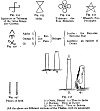
Click to enlarge
Figs. 232-238
|
Fig. 232: Signature or Talisman of the Jaina Kings: also Gnostic |
The crook part of a Bishop's staff shows the undulating curve of S.S. issuing out of the foliations: meaning the Blessed Virgin Mary. This is particularly observable in the statue of William of Wykeham, the founder, at St. Mary's College, Winchester; who, holding the spiritual crook in the left hand, gives the usual benediction of the two extended fingers with his right. The crook is the Shepherd Crook of the 'Second Person', and of the 'Holy Spirit'.
We now give a series of Gnostic Talismans, from originals. The reader is requested to refer to our numerous figures and symbols from the Temple Church,
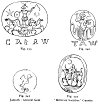
Click to enlarge
Figs. 239-242
|
Fig. 241: 'Mithraic Sacrifice' Gnostic; Fig. 242: Jacinth: Gnostic Gem. |
[paragraph continues] London, and to the insignia of the Templars, as displayed in all countries, for hints as to their connexion with the mysterious beliefs constituting that which is called Gnosticism.
Concerning the Pillars of Seth (see fig. 237), Josephus asserts that No. 1 was existent in his time. It is a Cabalistic tradition that No. 2 was destroyed in the Deluge. Notice also their resemblance to the Phallus or Phallos, Lingam or Lingham. Lithoi = Ll-th-oi.
Figs. 239-240, represent, under different aspects, the armed Abraxas, the chief deity of the Gnostics. In fig. 239 he is displayed with characteristics of Apollo, or the Sun rising in the East, in the quadriga or four-horsed chariot. Fig. 240: 'Abraxas brandishing his whip, as if chasing away the evil genii.

Click to enlarge
Fig. 243, 244
|
Fig. 243: Egyptian Apis, or Golden Calf |
[paragraph continues] On his shield; the titles ΙΨ. ΙΑΩ. Neat work. Green jasper' (The Gnostics, p. 201).
The 'Uræon', or winged solar disc, or egg, from which issue, on reversed sides, the two emblematical asps, has certain characteristics which ally it with the 'Scarabæus'. Both Uræon and Scarabæus are symbols continual on the fronts of the Egyptian temples, and they are principally placed over the portals; they are talismans or charms.
Fig. 248: 'Osiris', or the 'Old Man'; a terminal figure. At the foot, the celestial globe and masonic pentagon, or 'Solomon’s Seal'. The field is occupied by symbols and letters, seemingly Hebrew. The whole design is mediæval, hardly a production of even the lowest times of the Empire. This is one of the pieces most evidently bespeaking a 'Rosicrucian' origin. Deeply cut in a coarse-grained green jasper (Gnostics, p. 213).
Fig. 249: Anubis walking; in each hand, a long
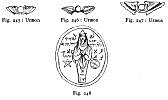
Click to enlarge
Figs 245-248
|
Fig. 245: Uræon; Fig. 246: Uræon; Fig. 247: Uræus |
[paragraph continues] Egyptian sceptre terminating in a ball; in the field, the sun and moon (adjuncts marking the astrological character of this talisman, which therefore must be ascribed to the class of Abraxoids). The whole enclosed in a sunken circle. Rev. MIXAHA, between four stars. The Cabalists make Michael the Angel of the Sun. Plasma of bad quality (The Gnostics, p. 200).
Fig. 250: This object is the 'Chnuphis Serpent', to which frequent reference has been made in our book. The 'Serpent' is raising itself in act to give the mythic dart. On its, head is the crown of seven points or vowels. The second amulet presents the name of the Gnostic 'Unknown Angel', with the four stars in the angles. This is Michael or the 'Saviour', the 'Chief of the Æons', seventy-two in number, and composed of six times twelve; there being three 'double decades', for the night and for the day, in each lunar period or sign of the zodiac; each of which consists of thirty degrees. In another aspect, this symbol stands for the Gnostic Chief Deity Abraxas, the letters of whose name make up the number of days of the solar circle.
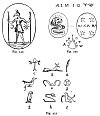
Click to enlarge
Figs. 249-251
The following group of figures gives some of the significant hieroglyphs from the Egyptian sculptures. (a) Plume, 'Spiritual Power' (b) Jackal, 'Priesthood'. (c) Tau, Fleur-de-Lis, Crux-Ansata. (d) Placenta, 'Religious Solemnities'. (e) Horns, 'Power'. (f) Anser, 'Prudence'. (g) 'Nonage'. (h) Asp, 'Sovereignty'. (i) Hawk, 'Sagacity'. The Lotus-headed Sceptre means 'Religious Authority'. A Snake-headed Rod or Staff signifies 'Military Dominion'. A Snaky Rod or Sceptre is the 'Lituus' or 'Augur's Divining-rod', when it is curved at the lower as well as the upper end. It is said that this was the sceptre of Romulus.
We give in another place the Procession of the 'Logos', or 'Word', according to the Gnostics,
Fig. 252: 'The Good Shepherd bearing upon his shoulders the Lost Lamb, as he seems to the uninitiated eye: but on close inspection he becomes the double-headed Anubis; having one head human, the other a jackal’s, whilst his girdle assumes the form of a serpent, rearing aloft its crested head. In his hand is a long hooked staff. It was perhaps the signet of some chief teacher or, apostle among the Gnostics, and its impression one of the tokens serving
for mutual recognition mentioned by Epiphanius. Neatly engraved in a beautiful red sard, fashioned to an octagon form; a shape never met in the class of antique gems, though so much affected in Mediæval art, on account of its supposed mystic virtues' (The Gnostics, p. 201).
One of the Gnostic Gems, reputed the most efficacious of amulets, is of red jasper, and presents the Gorgon's Head ('Gorgoneion'), with the legend below, 'ΑΡΗΓΩ ΡΩΠΟΜΑΝΔΑΡΗ', 'I protect Rhoromandares'.
In India, the 'Great Abad' is Bhudda; Bauddha, Buddha, or Baddha. There is a connexion. suggested here with the 'Abaddon' of the Greeks. In the same way, a relation may be traced with 'Budha’s Spiritual Teacher'; who was the mythic Pythagoras,
the originator, of the system of transmigration, afterwards transplanted to Egypt, and thence to Greece. Thus in Sanscrit it is 'Bud’ha-Gooros'; in Greek it is 'Pythagoras', in English it is 'Pythagoras'; the whole, 'Budha's Spiritual Teacher'.
The crista, or crest, or symbolic knob of the Phrygian cap or Median bonnet, is found also, in a feminine form, in the same mythic head-cover or helmet, for it unites both sexes in its generative idea, being an 'idol'. In the feminine case--as obviously in all the statues of Minerva or Pallas-Athene, and in the representations of the Amazons, or woman-champions, or warriors--everywhere the cap or helmet has the elongated, rhomboidal, or globed, or salient part in reverse, or dependent on the nape of the neck. This is seen in the illustration of the figure of the armed 'Pallas-Athene', among our array of these Phallic caps. The whole is deeply mythic in its origin. The ideas became Greek; and when treated femininely in Greece, the round or display--which in the masculine helmet was naturally pointed forward, saliently or exaltedly (the real 'christa', or 'crest')--became reversed or collapsed, when worn as the trophy on a woman's head. On a narrow review of evidence which evades, there is no doubt that, these classic helmets with their 'crests', this pileus, Phrygian cap, Cap of Liberty, or the Grenadiers’ or Hussars’ fur caps, or cocked hats, have all a phallic origin.
The Cardinal's 'Red Hat' follows the same idea in a different way; it is a chapel, chapter, chapiter, or chapeau, a discus or table crimson, as the mystic feminine 'rose', the 'Queen' of Flowers, is crimson. The word 'Cardinal' comes both from Cardo (Hinge, Hinge-Point, 'Virgo' of the Zodiac), and also from Caro, It. Carne, flesh--the Word made flesh.'
It is probable that these mythological hints and secret expressions, as to the magic working of nature, were insinuated by the imaginative and ingenious Greeks into dress and personal appointments. In the temples, and in templar furniture, mythological theosophic hints abound; every curve and every figure, every colour and every boss and point, being significant among the Grecian contrivers, and among those from whom they borrowed--the Egyptians. We may assume that this classic Grecian form of the
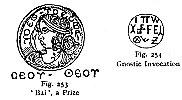
Click to enlarge
Figs. 253, 254
|
Fig. 253: 'Bai', a Prize; Fig. 254: Gnostic Invocation. |
head-cover or helmet of the Athenian goddess Pallas-Athene, or Minerva, not only originated the well-known Grecian mode of arranging women's hair at the back, but that this style is also the far-off, classic progenitor of its clumsy, inelegant imitation, the modern chignon, which is only an abused copy of the antique. In our deduction (as shown in a previous group of illustrations) of the modern military fur caps--particularly the Grenadier caps of all modern armies, as well as those of other branches of the military service--from that common great original, into which they can be securely traced, the mythic Phrygian cap when red, the Vulcan's pileus when black, we prove the transmission of an inextinguishable important hint in religion.
The following are some of the most significant talismans of the Gnostics:

Click to enlarge
Figs. 255-257
In fig. 255 we have the representation of the Gnostic Female Power in Nature--Venus, or Aphrodite, disclosing in the beauty, grace, and splendour of the material creation. On the other, or terrible, side of her character, the endowments of Venus, or of the impersonated idea of beauty, change into the alarming; these are the attributes of the malific feminine elementary genius born of 'darkness' or 'matter', whose tremendous countenance, veiled as in the instance of Isis, or masked as in that of the universal mythological Queen of Beauty, inspires or destroys according to the angle of contemplation at which she is mythically revealed.
Fig. 256 (A) is the crested 'Snake', curved as the symbol of the 'Dragon’s Tail', traversing from left to right the fields of creation, in which the stars are scattered as 'estoiles', or waved serpentining flames--the mystic 'brood' of the 'Great Dragon'. The reverse of this amulet (B) presents the 'crescent'
and 'decrescent' moons, placed back to back, with a trace or line, implying that the 'Microcosmos', or 'Man', is made as between the 'Moons'. This
figure suggests a likeness to the sign of the 'Twins', and to that of the February 'Fishes'.
Fig. 257 is the mythological 'Medusa's Head', terrible in her beauty, which transforms the beholder to stone. This direful head is twined around with snakes for hair, and the radii which dart from it are lightning. It is, nevertheless, esteemed one of the most powerful talismans in the Gnostic, preservative group, though it expresses nothing (in a strange, contradictory way) but dismay and destruction.
Fig. 258 is referred to in a previous part of our book as fig. 313.